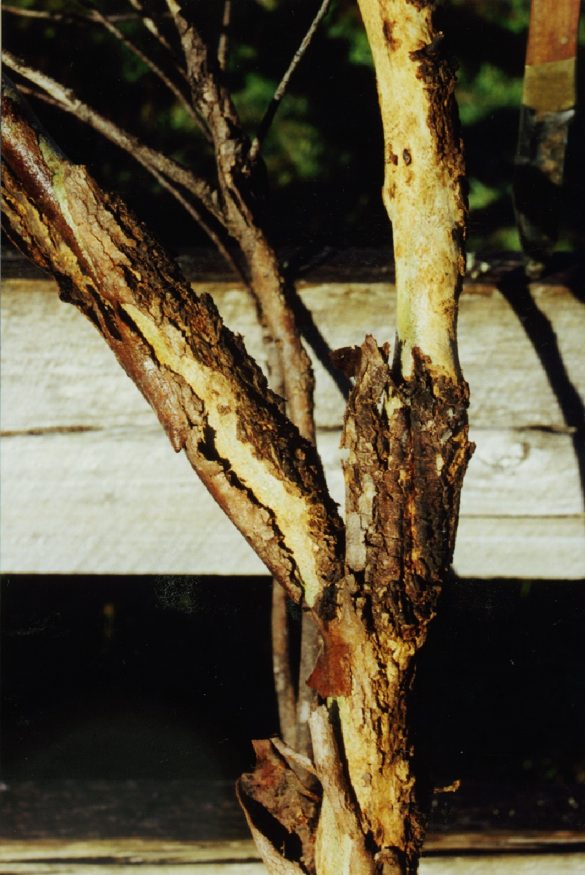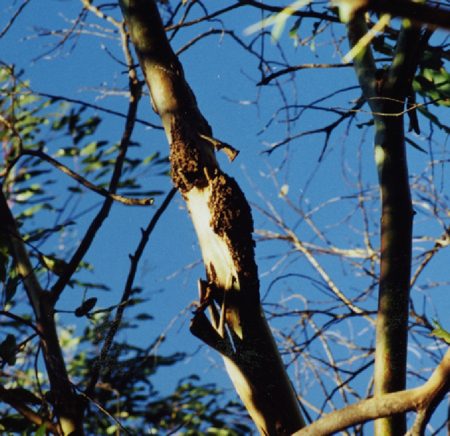PESTS AND DISEASES OF FORESTRY IN NEW ZEALAND
Disease affects eucalypts in South Island
Scion is the leading provider of forest-related knowledge in New Zealand
Formerly known as the Forest Research Institute, Scion has been a leader in research relating to forest health for over 50 years. The Rotorua-based Crown Research Institute continues to provide science that will protect all forests from damage caused by insect pests, pathogens and weeds. The information presented below arises from these research activities.
From Forest Health News No. 86, June 1999.
 Swollen, fissured cankers on branches of Eucalyptus nitens (14-19 years old) growing on the West Coast were first noticed and sampled during a routine survey by Paul Bradbury, Forest Research Forest Health Adviser, in August 1998. Since this discovery the disorder appears to have spread rapidly from a small area of about 26 ha to an overall area of 5 square km which encompasses 60 ha of E. nitens . The number of cankers per affected tree has increased over this period, larger branches than found initially are now cankered and on some trees the cankers occur on the stem. Although the sapwood beneath the cankers on the larger branches and the stems appears unaffected, dieback associated with cankers on smaller branches is occurring. In every sample examined an undescribed species of Sarcostroma (previously Seimatosporium) has been found sporulating on the cankered tissue.
Swollen, fissured cankers on branches of Eucalyptus nitens (14-19 years old) growing on the West Coast were first noticed and sampled during a routine survey by Paul Bradbury, Forest Research Forest Health Adviser, in August 1998. Since this discovery the disorder appears to have spread rapidly from a small area of about 26 ha to an overall area of 5 square km which encompasses 60 ha of E. nitens . The number of cankers per affected tree has increased over this period, larger branches than found initially are now cankered and on some trees the cankers occur on the stem. Although the sapwood beneath the cankers on the larger branches and the stems appears unaffected, dieback associated with cankers on smaller branches is occurring. In every sample examined an undescribed species of Sarcostroma (previously Seimatosporium) has been found sporulating on the cankered tissue.
This species of Sarcostroma was first recorded from Rotoehu Forest in 1986 and was associated with galling on branches and leaf veins of E. stenostoma . A specimen on twigs of E. regnans from the Rotorua area was lodged in the Forest Research Mycological Herbarium in 1988. On this host the fungus was associated with twig lesions and minor dieback. A further collection of the fungus was made in 1998 in the Nelson bioregion where it was associated with minor dieback of a species of Eucalyptus from a mixed stand of E. delegatensis, E. nitens and E. regnans (Ben Doherty, Forest Health Adviser). Eucalyptus regnans and E. obliqua adjacent to the affected E. nitens on the West Coast are unaffected.
 The role of the fungus in the condition found on E. nitens remains somewhat uncertain, though consistent association of a fungus with a set of symptoms, in the absence of other recognisable causes, indicates that a relationship is likely. No development of symptoms on either E. stenostoma or E. regnans following the records of 1986 and 1988 in the Bay of Plenty was noted; whether this is primarily a host response or related to environmental conditions is, at present, a matter for speculation. Further investigations are being carried out by the Forest Health Reference Laboratory.
The role of the fungus in the condition found on E. nitens remains somewhat uncertain, though consistent association of a fungus with a set of symptoms, in the absence of other recognisable causes, indicates that a relationship is likely. No development of symptoms on either E. stenostoma or E. regnans following the records of 1986 and 1988 in the Bay of Plenty was noted; whether this is primarily a host response or related to environmental conditions is, at present, a matter for speculation. Further investigations are being carried out by the Forest Health Reference Laboratory.
(Paul Bradbury and Margaret Dick, Forest Research)
This information is intended for general interest only. It is not intended to be a substitute for specific specialist advice on any matter and should not be relied on for that purpose. Scion will not be liable for any direct, indirect, incidental, special, consequential or exemplary damages, loss of profits, or any other intangible losses that result from using the information provided on this site.
(Scion is the trading name of the New Zealand Forest Research Institute Limited.)

 Farm Forestry New Zealand
Farm Forestry New Zealand

